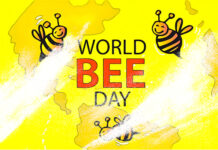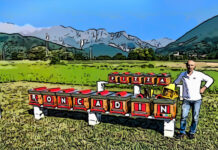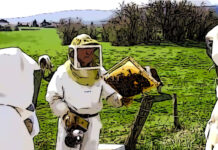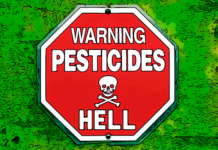Tall grass is helpful in preserving biodiversity and encouraging pollinating insects, bees first and foremost. According to other views, it may instead express a sign of degradation and/or danger to citizens. The debate is now underway at the City of Turin, where Ecological Left group leader Alice Ravinale has proposed reducing grass mowing in city green areas.
The Metropolitan Pollinators Community, in an open letter (see attached) also signed by Égalité, calls for more attention than what is already being done in other areas of Italy and Europe. As well as the establishment of a support body to the Turin Council that can bring the necessary know-how to ‘greener greens. (1)
Tall grass for biodiversity, pollinators and temperature
Reducing mowing in green areas has the function of protecting the soil from evaporation and saving water, so as to counteract the effects of the extraordinary heat and provide a more favorable environment for pollinating insects as well. (2)
Opposing voices on the other hand argue that such a measure may result in the degradation of city green areas, with possible risks of harm to people and animals (e.g., dandelions that can penetrate the skin and mucous membranes of dogs). (3)
Designing with care
The Metropolitan Pollinators Association, without lingering in controversy, highlights the criteria to be followed in order to better manage public greenery while respecting the needs-now imperative-of health, the environment and pollinating insects.
The open letter recalls
– the criteria outlined in the standards for the development of urban green spaces (Law Jan. 14, 2013, no. 10. Regulations for the Development of Urban Green Spaces) establishing the ‘Committee for the Development of Public Green Space‘ and introducing the possibility of adopting measures to promote energy saving and efficiency, absorption of fine particulate matter and reducing the summer heat island effect,
– the Ministry of Environment and Energy Security’s ‘Guidelines ‘for Urban Green Management and First Directions for Sustainable Planning’ (MASE, 2017). The chapter on urban green design refers precisely to the need to protect and increase local biodiversity by creating ideal environments for pollinating insects. Including the identification of compatible areas with reduced maintenance and the introduction of ‘wild meadows’ or ‘flower meadows’.
Bee-friendly municipalities
The hypothesis of reconciling the enjoyment of public green space with the protection of pollinating insects is by no means new or whimsical.
‘United (DISAFA) develops and enriches its own mapping of urban greenery, also making use of the data provided by melissopalinological analyses, drawing on expertise that, in terms of botanical species and botanical species of interest to pollinating insects, is a historical reference in the national territory,’ metropolitan pollinators recall.
The Bee Friendly Municipalities Network, founded in 2017, is participated by 213 municipalities and rests on a decalogue already proposed to the Turin administration. To the same end, the Pesticide-Free Cities network is operational, interconnected with the European Citizens’ Initiative‘Save Bees and Farmers,’ which has collected more than one million signatures to curb agrotoxin abuse.
Successful experiences
The evolution of public green management to ‘environmentalism’ after decades of herbicides and cementing is already an established reality, in spite of the controversy of these days.
In Emilia-Romagna, the ‘Bees and Environmental Greening Project’ (established by CONAPI and Centro Agricoltura Ambiente G. Nicoli) provides the dozens of member municipalities with scientific technical accompaniment accompanied by citizen outreach tools that include an information bulletin on the issues of bee conservation and the management of ornamental, public and private green spaces with low environmental impact.
The urgency of addressing the issue is reiterated in the ISPRA Report signed by Metropolitan Pollinator Community, Slow Food, which addresses the issue of urban greenery and ecological transition and sustainability (350/2021).
Initiatives in the Turin area
The Turin area, moreover, has been home to innovative solutions supporting a redevelopment of the city’s green heritage for the past few years. With attention to meeting the needs of pollinating insects as well.
Such spontaneous city and private entity initiatives compete through regional or European calls for proposals to bring innovative environmental and social solutions to the city that are permanent and benefit biodiversity (such as the Florist Project).
The demands on public administrators
The signatories of the open letter therefore ask the City of Turin and the Environmental Department of Piedmont Region for more attention and inclusion, an openness to dialogue that considers the favorable experiences of public entities that have already addressed these issues and the opportunity to join the aforementioned networks. Therefore, one must:
– Apply the criteria and pursue the minimum objectives described in the MASE guidelines,
– verify and if necessary expand the green database-mapping, based on what DISAFA has already done, also in synergy with any other research projects,
– Tolerate and insist on respecting the phenological stages of meadow botanical species ensuring optimal cuts. Thus ensuring scalarity and trophic sources for pollinating insect species. Without neglecting possible risks also related to reduced usability of public spaces, where applicable. It is useful in this regard to inform and involve citizens directly and through agencies, committees, and constituencies,
– activate a pathway that can include university and third sector expertise and experience in civic advisory bodies inherent to urban green management.
Notes
(1) ANNEX, the letter from the Metropolitan Pollinator Community.
(2) Paul Varetto. City now defends tall grass: don’t cut it for biodiversity. The Press.https://www.lastampa.it/torino/2023/07/18/news/comune_torino_difesa_erba_alta_biodiversita-12951741/
Professional journalist since January 1995, he has worked for newspapers (Il Messaggero, Paese Sera, La Stampa) and periodicals (NumeroUno, Il Salvagente). She is the author of journalistic surveys on food, she has published the book "Reading labels to know what we eat".








